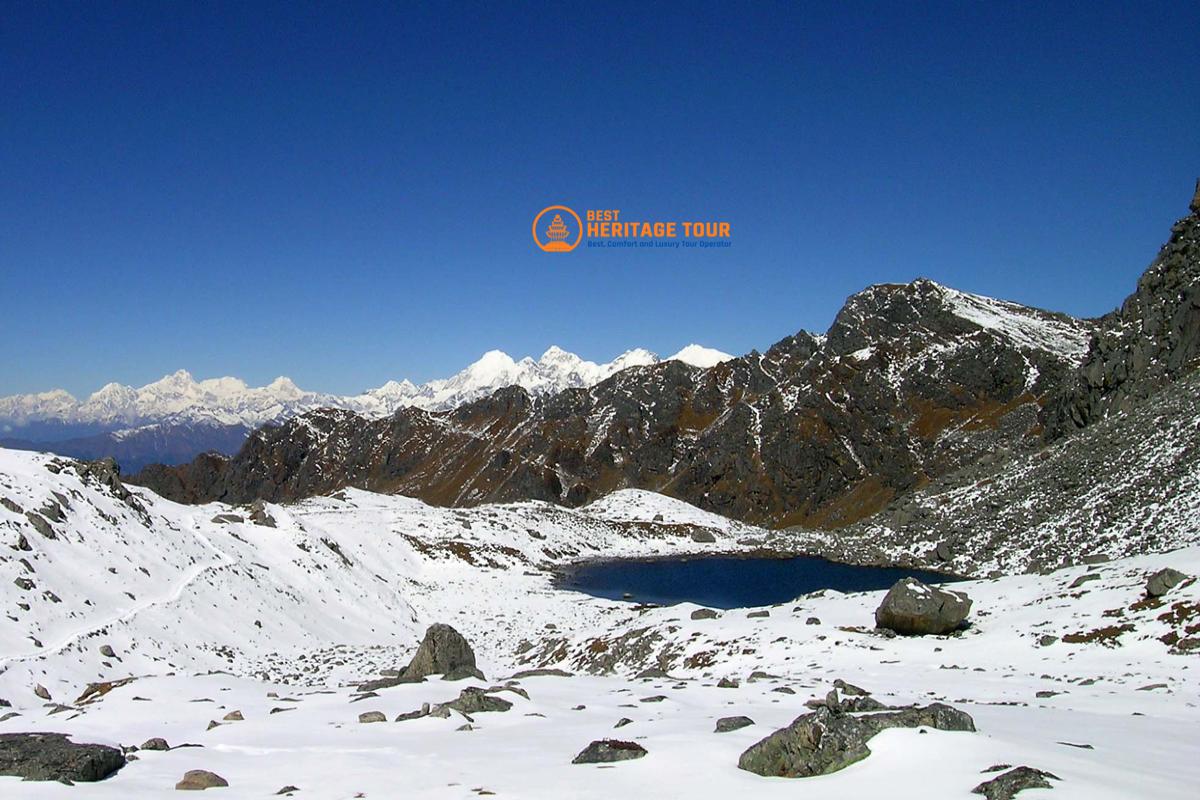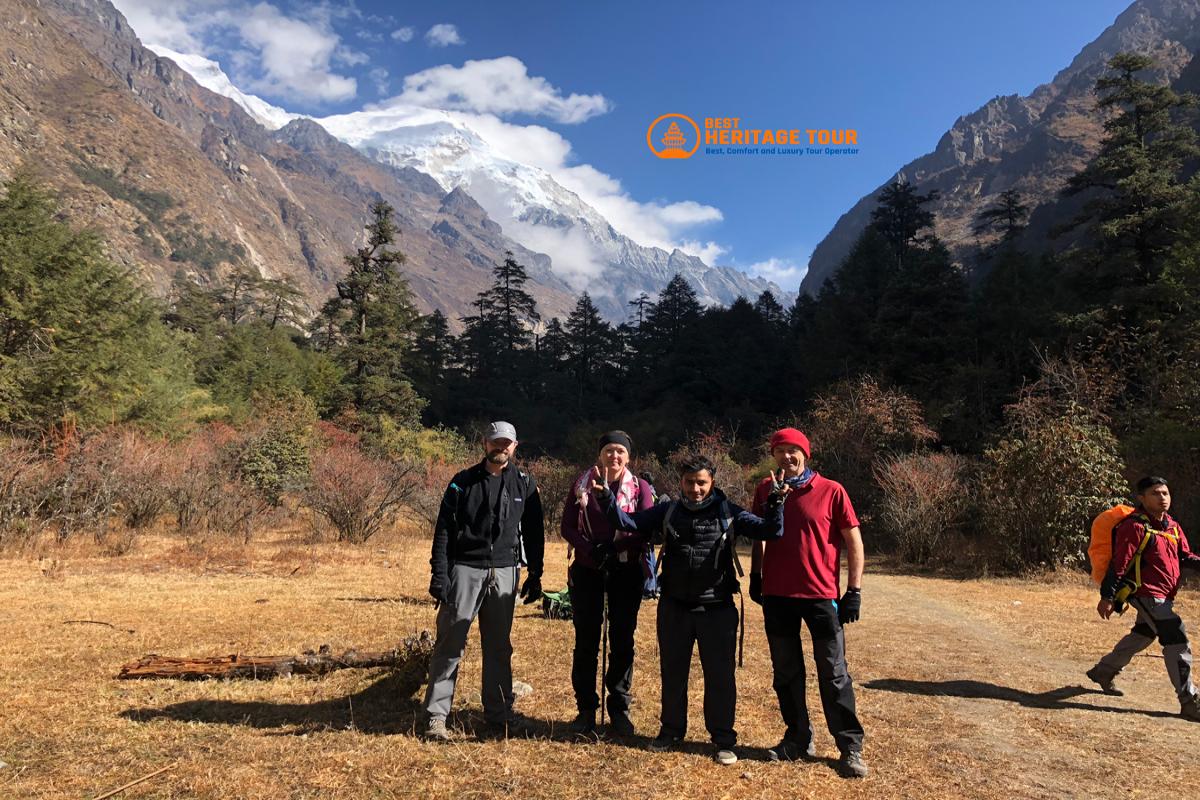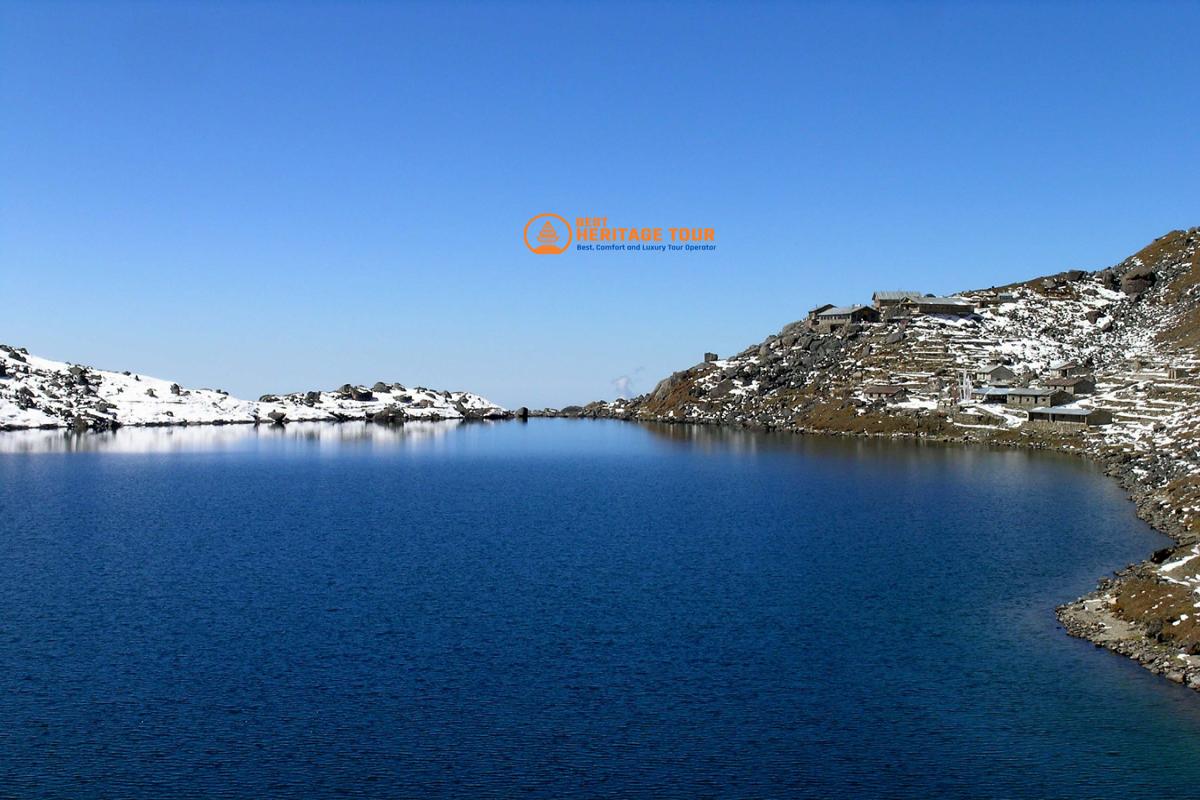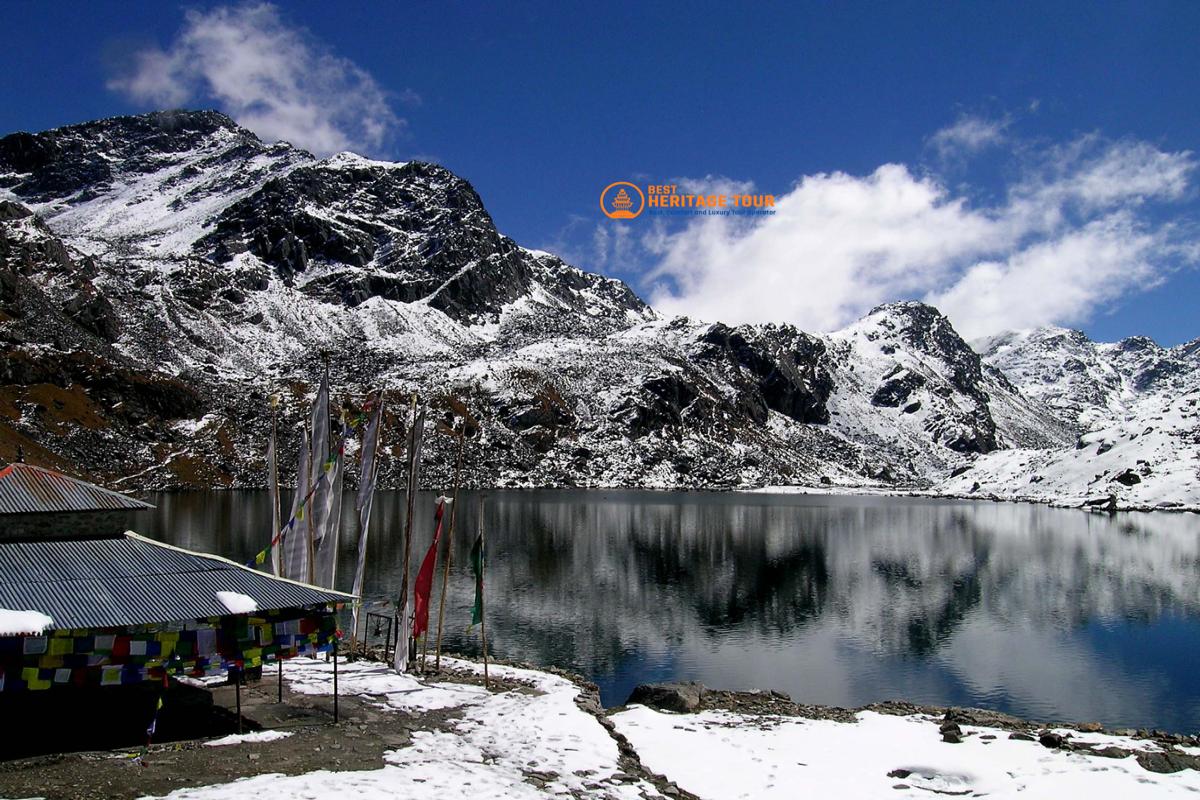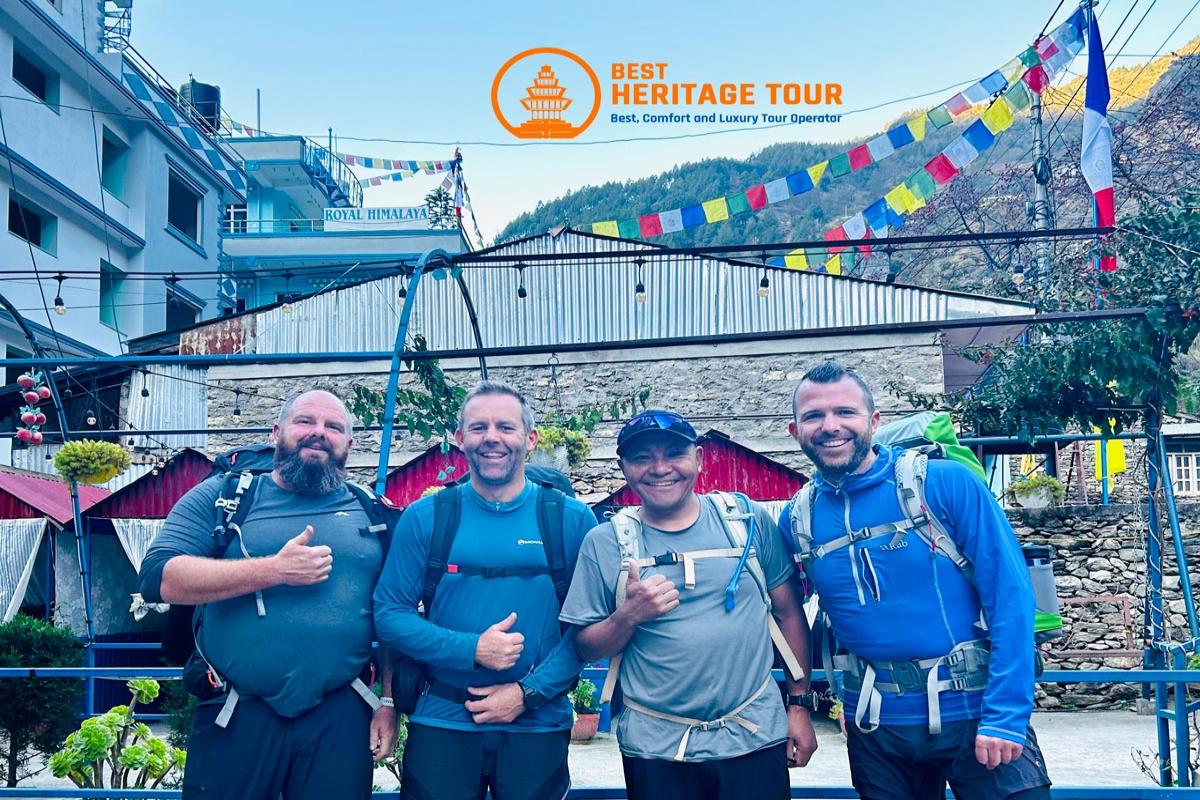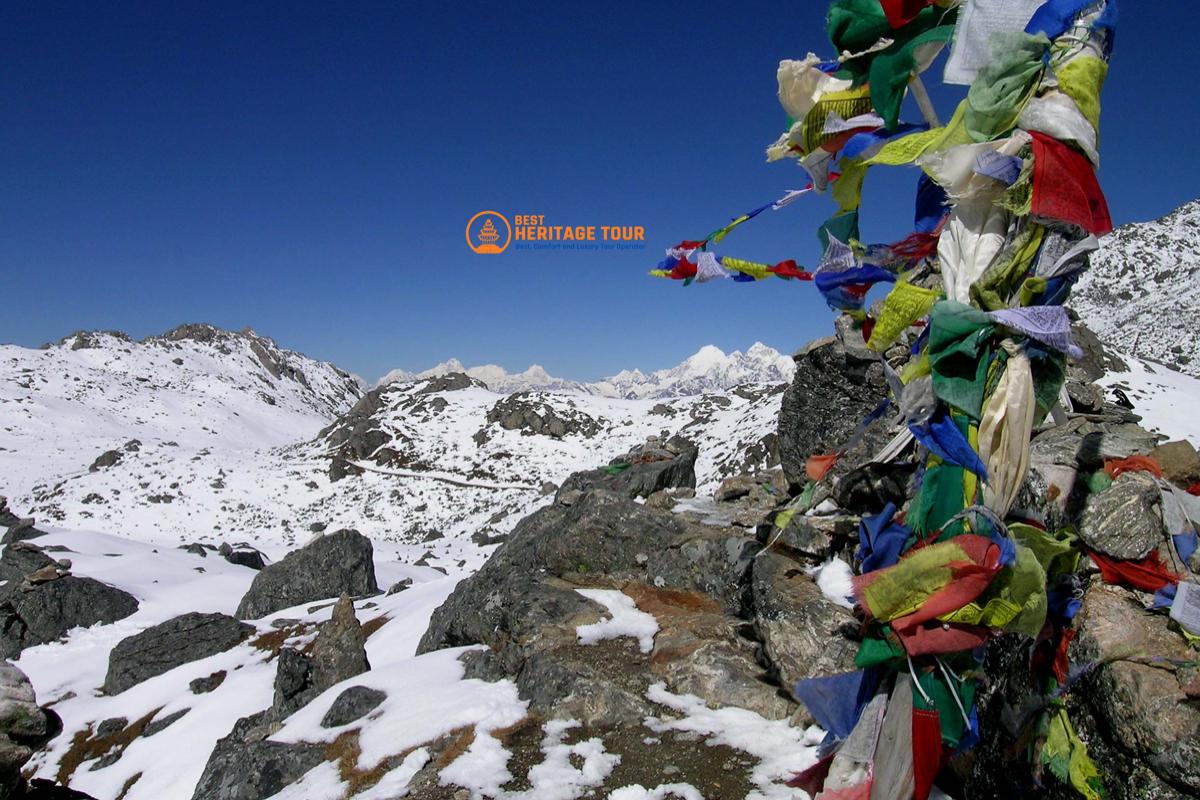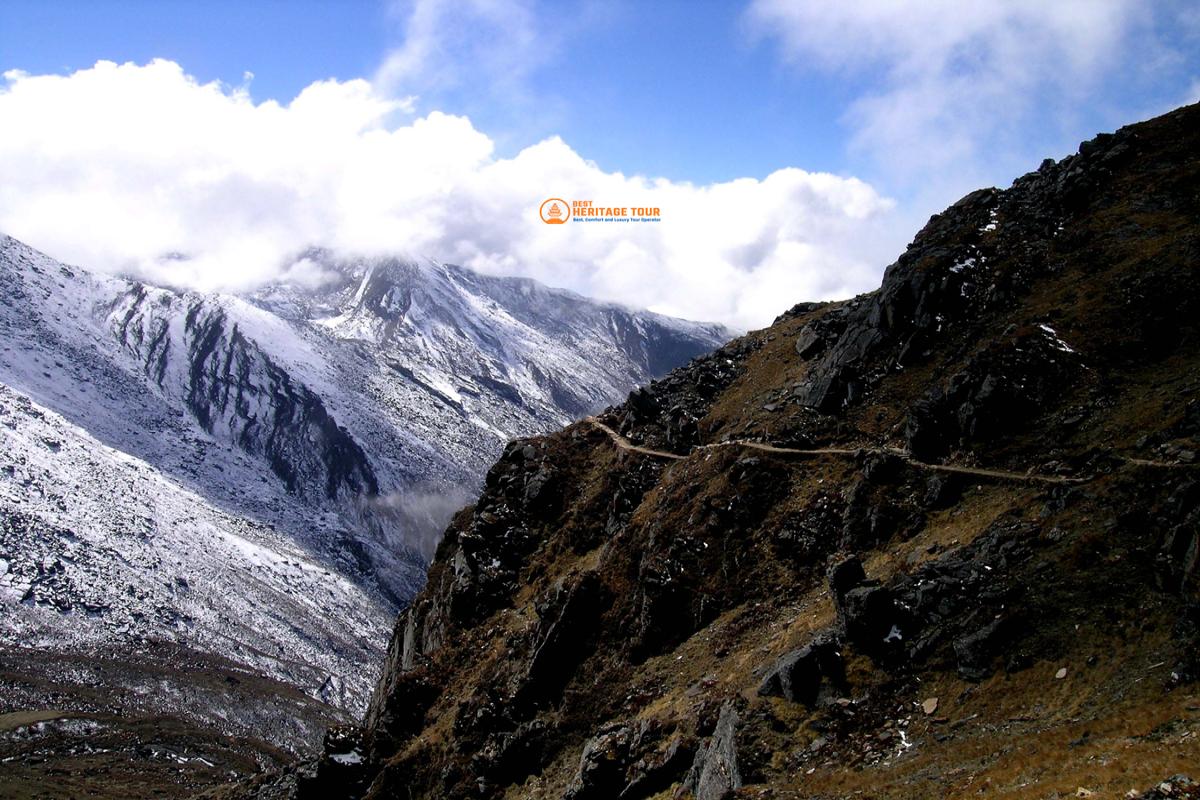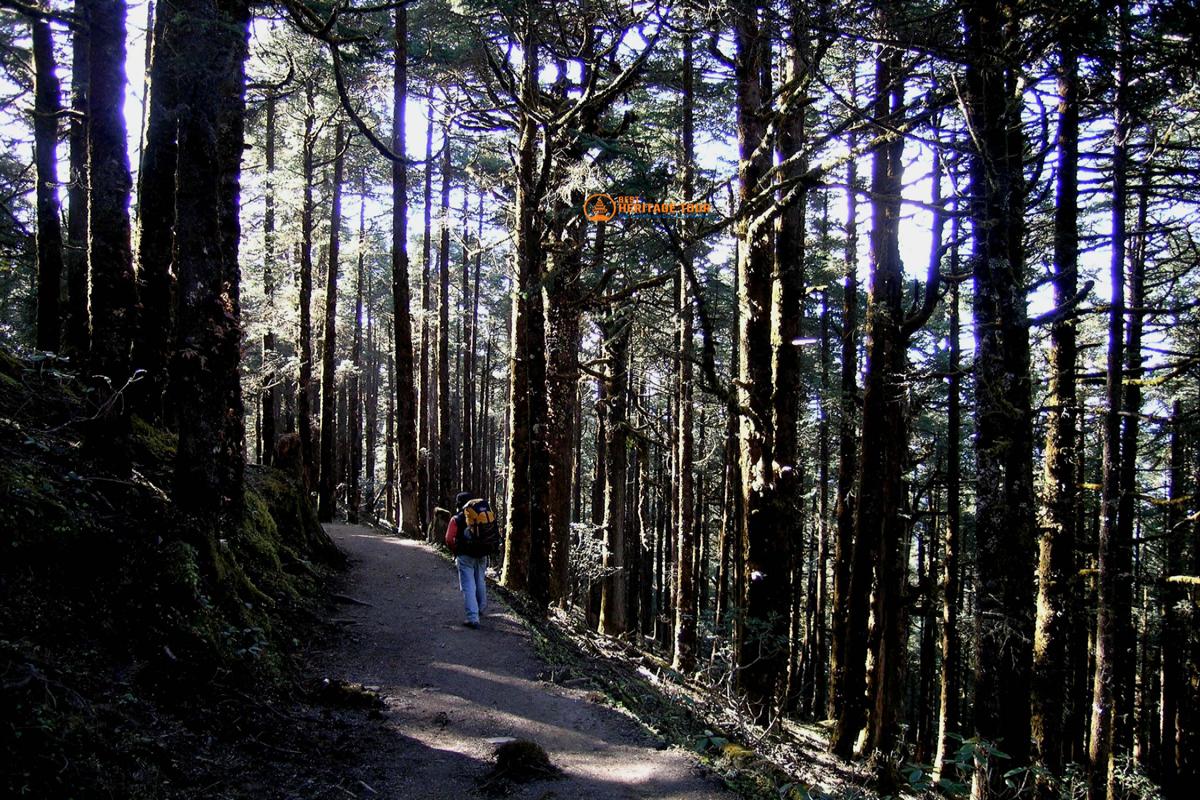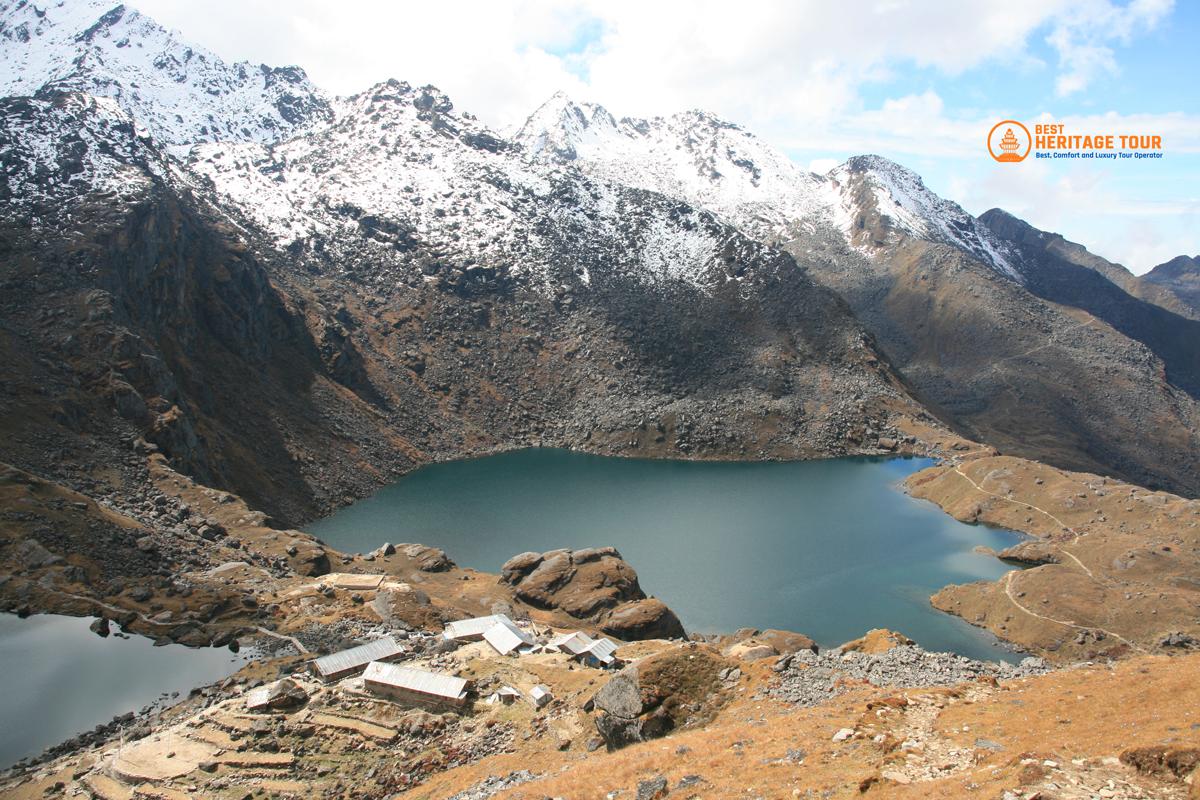Langtang Gosaikunda Trek - 13 Days
Insight on Langtang Gosaikunda Trek
Langtang Gosainkunda trek is for those who want to see the hillsides and high altitude lakes including the sacred Gosainkunda Lake and other glaciers of the Himalayas. This trekking area is situated to the north of Kathmandu, close to the Nepal-Tibet border.
Trip at a Glance
Highlights of Gosaikunda Langtang Trek
- Visit Langtang with its glacial valleys, pine forests, green meadows and terraced fields.
- Beautiful views of snow-capped mountains, waterfalls, deep valleys, millstones and suspension bridges
- Majestic views of Langtang Lirung (7,345m), Gang Chenpo (6,388m), Naya Khangga (5,846m), Dorje Lhakpa (6,966m), Kimsung (6,781m) and Yangsa Tsenji (6,575m)
- Tibetan border region
- Beautiful Lirung and Kimsong Glaciers
- Explore the nearby cheese factory located in Kyanjin Gompa.
- Ancient Buddhist monasteries, prayer flags and chortens
- Explore the sacred Gosainkunda Lake, which is located at an elevation of 4,600 meters.
- Detour to Kyanjin Ri (4,773m) and Tsergo/Cherkoli (4,984m) view points
Benefits of booking Langtang Gosainkunda Trek with Best Heritage Tours
- Complimentary private car transfers are provided from the airport to the hotel upon arrival and from the hotel to the airport upon departure.
- Online travel briefing after booking confirmation
- Pulse oximeter to monitor blood oxygen saturation at high altitudes for early detection of altitude sickness and other potential health risks
- Medical kit
- Easy booking and reservation system
- We offer multi-channel communication options, including email, WhatsApp, Facebook, WeChat, Viber, Skype, and Zoom.
- 24/7 phone contact: +977- 9851149197/ +9779810043046
- Simple payment system.
- Free luggage storage at BHT store during the trek
- Sleeping bags and down jackets can be arranged for those who do not have their own
Online Travel Briefing
The online briefing will clear all your doubts about the trek, including what you need to bring for the trek (equipment checklist), itinerary details, and precautions on the trail. Once your booking is completed, we will email you the date and time available for you to join the trekking meeting. Once we receive all the required documents, we will conduct an online trekking meeting.
Comprehensive Langtang Gosainkunda Trek
The Gosainkunda Langtang Trek is among the most sought-after destinations within Langtang National Park.It is located in the north-east of central Nepal, near Kathmandu. In fact, it can be seen from the Kathmandu Valley. On this trek, you will experience deep valleys, rocky terrain, pine forests, yak pastures, glimpses of Buddhist religious practices, mystical monasteries, picturesque villages, mountain terraces, tranquil valleys and breathtaking glaciers emerging from the high mountains. The hike will also take you to the sacred Gosainkunda (4,380 m), an alpine freshwater lake high in the Rasuwa range.
This trek starts with a drive along the Trishuli River, which flows north from Kathmandu through Trishuli Bazar and Dhunche, and finally to Syabrubesi. Your trek will commence in Syabrubesi, a Tamang village situated along the banks of the Bhote Kosi River. We will hike along the Langtang River to reach Lama Hotel where we will stay for the night. On the following day, we will trek from Lama Hotel to Langtang Village, which is a significant Tamang community. From Langtang we will head to Changin Gompa. A day will be set aside at Changin Gompa for acclimatization. During the acclimatization period we will have the opportunity to visit the Yak Cheese Factory, Tserkoli View Point and Changin Gompa Monastery. Subsequently, we will return to Lama Hotel and proceed through the stunning Langtang Valley to reach Gosaikunda, a revered pilgrimage site for both Buddhists and Hindus.The waters of Gosaikunda Lake are said to have magical healing powers. To reach Gosaikunda, trek from Lama Hotel to Thuro Shabru, then trek from Thuro Shabru to Cholampati and finally to Gosainkunda. In the beautiful Helambu region, trek over Laurebina La plateau pass to reach Ghopte after visiting Gosainkunda .From Ghopte, descend through rhododendron, pine and juniper forests and tranquil meadows to Kutumsang. The following day, keep going down and arrive at Chisapani through Pati Bhanjyang. On your final day of trekking, you'll trek from Chisapani to Sundarijal and then return to Kathmandu by bus.
This package includes public bus transportation; however, if you prefer more comfort, you can book a jeep at an additional cost.
Itinerary
After an early breakfast, start the scenic drive by local bus from Kathmandu Valley to Syabrubesi, northwest of Kathmandu. Along the way you will see beautiful scenery including fast-flowing rivers, terraced fields, typical Nepalese villages and snow-capped mountains. The road is flat until Trishuli Bazaar. Afterwards the road gets a bit bumpy as you drive to Dhunche and back to Syabrubesi, a bazaar town with a lot to explore, including relaxing riverside hot springs.
The first day of the hike starts from Syabrubesi. Cross the Bhote Kosi River to the Langtang River and follow it through fertile jungle and terraced fields. From here, you will pass a landslide area, climb up to Bamboo and gradually climb up to Limche on the bank of the Langtang River. Along the way, you will pass several rural settlements, bamboo and birch forests and you can spot rare native wildlife such as red pandas. Continue hiking to Lama Hoteldorf.
We continue hiking along the Langtang River, climbing through dense forests. Along the way, glimpses of snow-capped mountains beckon us forward. Finally, the narrow river valley widens at Goda Tabera, where a Tibetan relocation project was carried out in the past. We stop at the Goda Tabera military checkpoint to register our documents. We then cross the eastern side of the river and approach the Langtang Valley. We pass prayer wheels and prayer flags powered by running water and make our way to the beautiful Langtang village, inhabited by the Tamang people.
We continue to climb, passing small abandoned villages and grasslands. The vast Langtang Valley offers panoramic views of the majestic Himalayan ranges. Our route passes through several tributaries and glacial deposits. Finally, we reach what was once the largest settlement on our journey, a place called Kyanjin Gompa. The place is named after the ancient monastery Kyanjin Gompa nearby, which was heavily damaged in the 2015 earthquake and is mostly abandoned. After lunch, we climb to Kyajo Ri Viewpoint at an altitude of 5,150 meters and have great views of several mountain ranges and the Langtang Valley. However, this is an optional hike.
On this day, you will spend the night in Kyanjin Gompa for acclimatization. The upper Langtang Valley has stunning sights of tall mountains and glaciers. You will visit several attractions such as the Yak Cheese Factory and Kyanjin Gompa Monastery. If you wish, you can trek to Langshisha Khalka and Tserkoli Viewpoints (5,450m). From there, you can see Langtang Lirung (7,227m), Langtang II (6,596m) and Yala Peak (5,500m). In the evening, you will return to Kyanjin Gompa.
From Kyanjin Gomba we say goodbye to the highlands and start our descent on a route out of the valley. We follow the same path that led us to Kyanjin Gomba. As we travel, we go through Langtang village, stop for lunch at Gora Tabera, and check in for our departure at the military checkpoint.After a leisurely lunch we continue our descent through the dense forest of the river valley to Lama Hotel.
Today, you will descend to the banks of Langtang Khola and cross a small waterfall. The route takes you through rhododendron and bamboo forests and is full of wildlife, including wild boars and monkeys. The route offers stunning views of Ganesh Himal. At the end of today's hike, you will cross a suspension bridge and reach the base of the village of Turo Shabr.
From Thuro Shabru, the hike gradually climbs uphill and passes the army checkpoint at Langtang National Park. After a 30-minute climb, we reach Tara Port. From here, the trail is not as steep as we pass through hemlock and oak forests. Beyond the forest, we can even spot rare red pandas. We continue trekking through Dimsa and Shingompa to Chhorampati, where we stop for the night.
As we reach the peak, we are greeted by the beautiful Langtang Himal (7,234 m), the most famous peak in the entire Langtang range. We start our hike on a deserted and barren mountain path. The higher we climb, the more mountains we see on the horizon: the majestic Langtang Himal, Ganesh Himal and even Annapurna on the western horizon. After a few hours, we reach Lore Vinayak and start our climb to Gosainkunda. After a steep 2 hour climb you will reach the chorten and after a 1 hour hike you will be treated to beautiful views of waterfalls and lakes including Saraswati Kunda and Bhairab Kunda. Both lakes are formed by the water flowing from Gosainkunda. Hindus consider this place sacred as they believe it is the favourite place of Lord Shiva. Gosainkunda attracts thousands of pilgrims every year for the sacred Hindu festival in autumn.
Today you will cross the Laurebina La high pass and enter the picturesque Helambu region. The trail from Gosainkunda Lake will first descend from a hut to the lake. The hike then gets steeper along the north bank as you approach Laurebina La pass, passing no less than three small lakes before reaching the pass. Laurebina La pass is marked by a stone stupa and many prayer flags. This pass marks the highest point of the Langtang trek. You then descend through a wide valley to High Camp (4,240 m) before continuing the hike up a steep, rocky path to Phedi. Shortly after Phedi, you descend to a footbridge over the river. The trek from Phedi to Ghopte is challenging and requires a significant ascent.
We start our trek through juniper, rhododendron and pine forests in a remote and uninhabited area, and reach the tranquil plateau landscape of Talepati. From Talepati, we make a gentle descent through the forests of the western mountain slope. After a while, we pass through a wide grassland with the remains of shepherds' huts. The peaks of Gangchenpo and Dorje Lakpa are visible from the route. After that the descent becomes steeper and we pass through the forest to reach Magin Goth (3265m). After a short walk we pass Kuala Banjang (3335m) and descend to Kutumsang village (2470m).
From Kutumsang we climb for a while and descend to Guru Banjang village (2140m). Then we climb and reach the dusty wide road of Thorong Danda (2500m) and continue on the rough rocky path to chipping village. Then it becomes more and more downhill and we reach Pati Banjang (1760m), a village between Chipping and Chisopani. After a 30-minute hike, you will reach Chisopani, known for its amazing panoramic views of several mountains.
After a few minutes’ walk to Chisopani, you will reach the checkpoint of Shivapuri National Park. From here, you will descend the hill via a wide path and then ascend the hill via a paved path. Finally, you will reach Sundarijal (1460 m), passing several reservoirs and a large water pipe. There, you will bid farewell to the hiking trail and drive to Kathmandu by local transport.
What is included?
- Local bus from Kathmandu to Syabrubesi (trek start), Sundarijal back to Kathmandu (trek end)
- Accommodation (total 12 nights): 6 nights en suite accommodation at Syabrubesi, Langtang village, Kyanjin Gompa (2N) Turo Syabru, Chisopani, 6 nights standard room (twin room) at Lama Hotel (2N), Chollampati, Gosainkunda Lake, Gopte, Kutumsang
- All standard meals during the trek (13 lunches, 12 dinners, 13 breakfasts)
- Experienced trekking guides/leaders with national qualification from Best Heritage Tour (1 assistant guide for 12+ trekkers) and porters to assist trekkers.
- Maximum luggage weight is 8 kg per trekker.
- Costs for guides and porters cover food, insurance, wages, lodging, transport, and essential gear.
- Langtang National Park entry permit fee
- Fee for the Trekkers Information Management System (TIMS) card.
- Fresh seasonal fruits daily
- Rescue operations in case of complicated health issues (covered by travel insurance)
- BHT T-shirt and cap
- Receive a Best Heritage Tour Appreciation Certificate upon successful completion of the trek
- Farewell dinner at the end of the hike in Kathmandu
What is not included?
- International flight ticket
- The visa fee for entering Nepal at Tribhuvan International Airport is $25-30 for 15 days, $40-50 for 30 days, and $100-110 for 90 days.
- Excess baggage fee (up to 8 kg per person)
- You will have accommodation and meals in Kathmandu before and after your trip.
- Additional overnight stay in Kathmandu due to early arrival, late departure or early return from the trek.
- Personal expenses (shopping, snacks, boiled bottled water, hot (tea/coffee) and cold drinks, hot shower, alcohol, Wi-Fi, telephone, battery charging charges, additional carriers, etc.)
- Personal clothing and equipment.
- Travel insurance covering emergency rescue and evacuation at high altitude (mandatory)
- Gratuities for guides and porters
- Additional expenses due to delays due to circumstances beyond our control such as bad weather, unavailability of accommodation, changes in itinerary, etc.
- All expenses not mentioned in Itinerary/ Included section.
- All government taxes 13%, SSF, and 10% service charges
Route Map
Equipment
Gosaikunda Lake Trek requires preparation. Bring only basic clothing and accessories for the trek. The following list will help you pack what you need for the trek.
Head
- Sun hat or scarf
- Winter hat or insulated hat or wide-brimmed hat
- Headlamp with extra battery
Face
- Sunscreen
- Sunglasses with UV protection
- Face/body wipes
Hands
- Lightweight gloves
- Thick winter gloves
Body
- Hiking shirt
- Long-sleeved shirt
- Rain jacket with hood
- Fleece jacket
- Light cotton pants
- T-shirt (bring your own light wool)
- Polypropylene underwear
- Down jacket (rent in Kathmandu)
- Sweater
- Waterproof jacket and trousers
Footwear
- Hiking shoes
- Thick wool socks (bring an extra pair of thick, light socks)
Essential equipment
- Backpack or daypack (size depends on whether you use a luggage rack or not). Thermos
- Water treatment
- Walking stick
- Sleeping bag (-15 bag is best for high altitude trekking)
Bathroom amenities
- Medium sized dry towel
- Toothbrush
- Toothpaste
- Deodorant dental floss
- Biodegradable soap
- Nail clippers
- Small mirror
Personal accessories
- Money
- Clock
- Mobile phone
- Camera
Extra items
- First aid kit
- Extra passport photo and passport copy
- Notebook and pen
- Binoculars
Trip Info
Langtang Gosaikunda Trekking Weather, Altitude - Tour Package Information
Langtang Gosaikunda Trekking in Nepal
You will arrive at Tribhuvan International Airport in Kathmandu no later than 3pm the day before the start of the trip for final preparations. There will also be time to hold a personal meeting for those who were unable to join the online trip meeting. On arrival you will need to stay overnight in a hotel in Kathmandu. The following day, you will take a local bus to your destination. The hike starts from Syabrubesi (gateway to Langtang). Traveling from the starting point of Langtang trekking takes about 8 to 9 hours by local bus.Local transport (KTM to Syabrubesi and Sundarijal to Kathmandu) is included in the package. For more convenience, you can book a private jeep at an additional cost.
Free Airport Pickup
Best Heritage Tour provides free airport transfers for arrivals and departures for customers who book Langtang Gosaikunda trekking packages.A company representative will come to the airport with a brochure with your name on it. After the welcome, you will be presented with a kada or marigold garland and transferred to your hotel in a private vehicle.
Best Time to Trek Langtang Gosaikunda
While trekking to Langtang Gosaikunda, weather is an important factor to consider. The best times for an easy trek with stunning mountain views are spring and autumn. In winter, snowfall makes the trekking area colder, while in summer, monsoons make the trail wet and slippery.
Journey Difficulty: Fitness Level and Health
The Langtang Gosaikunda trek is easy and rewarding. Depending on the destination, the hike will take 3-6 hours per day with regular breaks to admire the mountain views. The trekking route includes long climbs, steep descents, rocky paths and steep tracks through forests. The fitter you are, the more comfortable and enjoyable the trip will be. Previous trekking experience is an advantage but not essential. This hike is not recommended for those suffering from sensitive medical conditions such as heart or lung diseases.
Electricity and battery charging, water supply during the hike
All lodges on the Langtang Gosaikunda Trek offer charging for cameras and power banks for an extra fee.During the hike, you can purchase packaged mineral water from local huts and shops along the route, or fill your water bottles with boiled water for an additional fee. We will provide you with water purification tablets if required.
Travel Insurance for Langtang-Gosaikunda Trek
Though unlikely, there is a risk of altitude sickness and other high altitude accidents on this hike. Therefore, travel insurance is mandatory for this trek. You should have comprehensive travel insurance that covers medical care and emergency repatriation, including the cost of helicopter rescue and high altitude evacuation. We will suggest insurance companies based on our valued customers' experience, but we do not sell insurance policies. In case of an emergency, we will forward your insurance information to the insurance company for processing in order to arrange rescue measures and transport you to a hospital for treatment. After booking your hike, please send us your insurance details.
Nepal Tourist Visa
All foreigners, except Indians, require a visa to enter Nepal. Visas can be issued on arrival at Tribhuvan International Airport. The latest visa information can be found at www.immigration.gov.np.
A passport with at least six months validity and a passport photo are required to apply for a visa. The current visa fee is $50 for 30 days, payable in cash on arrival at Tribhuwan International Airport. Nationals of China and SAARC countries receive free visas. Nationals of Nigeria, Ghana, Zimbabwe, Swaziland, Cameroon, Somalia, Liberia, Ethiopia, Iraq, Palestine and Afghanistan may not be able to obtain a visa on arrival. If you are a national of these countries, please contact your local Nepalese embassy. How much luggage can I carry on the Langtang Gosainkunda trek? The luggage weight is 8 kg per trekker. Porters will carry your luggage. There will be a porter for every 2 hikers. All luggage should not weigh more than 17 kg. However, we ask that you bring a regular backpack to hold your valuables and important documents. We recommend that you carry only what you need. Excess baggage can be left at your hotel or Discovery World Trekking store free of charge.
Safety on Langtang Gosaikunda Trek
Best Heritage Tour ensures the safety of our valued guests. We provide all the necessary equipment and first aid kits for your safety. Our trekking guides and guides have undergone extensive first aid training. For safety reasons, the whole team will stay together during the hike. If any hiker becomes unwell due to the altitude, the hike leader has the authority to decide whether to continue the hike or descend depending on the overall condition of the team.
In case of an emergency, a rescue helicopter will bring you back from the air (covered by insurance).
Review
Amazing trek and beautiful lake
I just got back from the langtang gosaikunda trek and it was such an amazing journey. From the driving to the trekking, each part did not back out to surprise me. The beautiful...
View DetailWonderful time with family in Langtang valley
Recently our family went in on a Langtang Gosaikunda trek and it turned out to be one of the best trek of ours. We were a family of 5 people including me, my husband and our 3...
View DetailGreat trekking experience
I had an unforgettable experience on the Langtang Gosikeunda trek with the Best Heritage Tour. The trek was well organized with beautiful views of snow-capped peaks, lush green...
View DetailFAQ's
Yes, all our guides are fluent in English and many speak other languages. This facilitates clear communication and enhances your overall experience.
Most trekking guides in Nepal speak basic to advanced English, which is enough for general communication about trekking and safety precautions. Some speak more fluent English, which will improve your overall trekking experience.
Yes, most visitors need a tourist visa to enter Nepal. A visa can be obtained on arrival at Tribhuvan International Airport in Kathmandu or applied for in advance at a Nepalese embassy or consulate.
Yes, you will need two passport-sized photos for both the visa application and the trekking permits, so it's a good idea to bring extra copies just in case.
You'll need a valid passport (with at least six months validity), a passport-sized photo, and the visa fee (which varies depending on the duration of stay).
To obtain the RAP, you’ll need:
- A valid passport.
- A Nepal visa.
- Travel insurance.
- Two passport-sized photos.
- A letter from your trekking agency detailing your itinerary and the names of the guide and group.
Yes, it’s possible to extend your visa if you wish to stay longer in Nepal. Extensions can be processed at the Department of Immigration in Kathmandu or Pokhara, but you should apply before your current visa expires.
You can exchange US dollars or Euros for Nepalese rupees upon arrival, but we recommend carrying cash in the local currency for most transactions outside of major cities.
Hygiene standards may vary. Most teahouses strive for cleanliness, but it is wise to temper your expectations, especially in remote areas.
Yes, teahouses are generally safe and many hikers have had good experiences with them, but it's wise to use common sense, lock up your valuables, and choose a reputable establishment recommended by your guide.
To ensure you are comfortable while trekking, your backpack should ideally weigh 10-15% of your body weight, usually around 10-15 kg (22-33 lbs).
Physical preparation is essential to a successful trekking experience. Begin an exercise program 6-8 weeks before your hike that focuses on:
- Aerobic exercise: Activities such as running, cycling, and swimming to improve endurance.
- Strength training: Leg, core, and upper body exercises to increase strength.
- Practice hiking: Fill up your backpack and go on a short hike to simulate trekking conditions.
Hiring porters is not mandatory but highly recommended. Carriers allow you to carry heavy loads and make the hike more comfortable. This also supports the local economy and creates jobs in the area.
It is important to stay hydrated while climbing. Bring a reusable water bottle and use water purification tablets or a filter if necessary. Pack energy-rich snacks such as nuts, energy bars and dried fruit to maintain your energy levels throughout the day.
Before any hike, test your equipment on a training hike to make sure everything fits well and works properly. Ensure that you break in your trekking footwear to prevent blisters and discomfort.
Yes, we recommend that you have a small first aid kit with some basic items such as adhesive tape, disinfectant wipes, painkillers, altitude sickness medication, and personal medications.
Yes, you can rent trekking gear in Kathmandu and other major cities. However, we recommend that you check the quality and suitability of the equipment before renting.
Acclimatization helps your body adapt to high altitudes and reduces the risk of altitude sickness. Gradual ascents and rest days are essential to acclimatize effectively.
Pay attention to your body's signals, especially when fatigue sets in.
- Take a break: Take a break when necessary and find a comfortable place to sit and relax.
- Stay hydrated: Drink water regularly and eat snacks to replenish your energy.
- Inform your tour guide: Should you begin to feel unwell, it is important to communicate this to your tour guide. They can assist in modifying the pace and itinerary as needed.
Training at altitude helps your body adapt to lower oxygen levels, which can be beneficial for hiking. However, it is not absolutely necessary. Being in good cardiovascular condition can also prepare you for the conditions.
In the event of altitude sickness, it is vital to descend to a lower elevation immediately and take time to rest. Drinking plenty of fluids and taking over-the-counter medications (such as ibuprofen) can help reduce symptoms. See a doctor if symptoms persist.
Consult your doctor for individual vaccination recommendations. Common vaccinations climbers should consider include:
- Tetanus
- Hepatitis A and B
- Typhoid
- Rabies (if in contact with wild animals)
The main health risks while trekking include:
- Altitude sickness: occurs when you ascend too quickly without adequate acclimatization, causing symptoms like headaches, nausea, and fatigue.
- Dehydration: Insufficient fluid intake can cause fatigue and headaches.
- Injuries: Falls and slips on uneven surfaces can cause sprains and fractures.
Trekkers are strongly encouraged to take out travel insurance. Make sure your insurance covers high altitude hiking, medical evacuation and trip cancellation. This gives you peace of mind and financial protection in case of emergencies or unexpected events.
In case of emergency:
- Keep calm: Staying calm helps you make better choices.
- Contact your tour guides. They are trained to deal with emergencies and know what is best.
- Use communication devices: If necessary, you can use satellite phones and emergency transmitters for communication in remote areas.
In remote and secluded areas, maintaining a sense of connection can prove to be quite challenging.
- Cellular Network: Most areas along the trek have good mobile coverage, especially in larger villages such as Samagaon. However, signals can be unreliable.
- Wi-Fi Availability: Some teahouses offer Wi-Fi, but the connection can be slow and there may be a charge.
- Satellite Phone: If traveling to an area without cell coverage, consider renting a satellite phone in case of emergency.
The Gosaikunda Lake trek is a 13-day journey through the Langtang region of Nepal. It combines cultural exploration with trekking through diverse landscapes including forests, rural villages, and high-altitude passes. Gosaikunda is a sacred lake, especially for Hindus, and is situated at an altitude of 4,380 meters.
The total distance covered in the trek is approximately 70-90 kilometers depending on the exact route and side treks
The Lauribina Pass represents the highest elevation point, standing at 4,610 meters.
The trek is considered moderately difficult. While it does not require technical climbing skills, the high altitude and long trekking days make it challenging for beginners. Adequate preparation, fitness, and acclimatization are key.
Best Heritage Tours stands out with its experienced guides who know the hiking trails well and provide insight into the local culture, flora, and fauna. Their dedication to sustainable tourism guarantees that trekking activities support local communities and safeguard the environment. Plus, a customizable itinerary lets you tailor the hike to suit your interests and pace, making it perfect for beginners and experienced hikers alike.
Yes, solo travelers can undertake this trek. However, it is recommended to hire a guide or join a trekking group for safety, especially in remote areas with less traffic.
The best seasons are during the spring (March to May) and autumn (September to November). These intervals provide consistent weather conditions, unobstructed skies, and moderate temperatures
At higher altitudes, particularly near Gosaikunda Lake, temperatures can drop to -10°C (14°F) during the night, especially in the winter months (December to February). Daytime temperatures during the trekking seasons range from 10°C to 20°C.
Monsoon season (June to August) brings heavy rain, making trails slippery and challenging. The region experiences frequent rain showers, with cloudy skies and leeches in lower-altitude areas. This period is not optimal for trekking due to limited visibility and muddy paths.
Yes, especially near Gosaikunda Lake and Lauribina Pass, you may experience strong winds and fog. In the late afternoon, clouds often form, which can affect visibility.
Yes, Nepal offers an electronic visa (e-visa) that can be applied for online before arriving. This process enables you to bypass the visa queue upon arrival at the airport. After completing the online application, you can get your visa stamped on arrival.
The tourist visa fees are as follows:
• 15 days: USD 30
• 30 days: USD 50
• 90 days: USD 125 Note that these fees are subject to change, so check the current visa fees before your trip.
In addition to the trek package cost, you should budget for:
- Meals and drinks in Kathmandu
- Personal expenses such as snacks, drinks, and charging electronic devices during the trek
- Tipping guides and porters
- Optional activities or sightseeing in Kathmandu
- Travel insurance
ATMs are only available in Kathmandu. It is advisable to carry sufficient Nepalese Rupees in cash for the trek, as ATMs are not accessible in the Langtang region.
No, previous trekking experience is not mandatory. However, a good level of physical fitness is necessary, as the trek involves walking for 5-7 hours per day and ascending to high altitudes.
While there is no formal age restriction, it is essential for trekkers to maintain good health and physical fitness. Children above the age of 12 and adults up to the age of 70 can generally complete the trek, provided they have good fitness levels.
While it is possible for first-time trekkers, it is advised that they prepare by engaging in regular physical activity and trekking practice on lower-altitude routes before attempting the Gosaikunda Lake trek.
Accommodation is typically in local teahouses, which are simple lodges offering basic facilities. Rooms usually have twin beds, and common areas are heated. Some teahouses may offer private bathrooms, but most have shared bathroom facilities.
Most teahouses in remote areas do not allow online reservations. However, during peak seasons, guides or trekking agencies can help secure rooms in advance. It’s recommended to have a guide manage accommodations, especially in crowded seasons.
Yes, teahouses usually provide blankets, but they may not always be warm enough at high altitudes. Bringing your own sleeping bag rated for cold weather is essential.
Yes, it's recommended to bring your own trekking poles. They provide essential support during steep ascents and descents, and are particularly helpful for managing balance on rough terrain.
You should bring sturdy, waterproof trekking boots with good ankle support. Ensure they are well broken-in before the trek to avoid blisters or discomfort.
Regular cardiovascular exercises like running, cycling, or swimming are great for building endurance. Include hiking or walking on uneven terrain with a loaded backpack to simulate trekking conditions. It’s also important to strengthen your legs, core, and balance through weight training or yoga.
Start a fitness routine several months before the trek to gradually build strength and endurance. Even light to moderate exercise a few times a week can help condition your body. You can also opt for shorter and easier treks first to gain experience.
Yes, altitude sickness can be a risk on this trek. The trek is designed to allow for gradual acclimatization, but it’s important to stay hydrated, walk slowly, and be aware of symptoms such as headache, dizziness, and fatigue. In case of severe symptoms, immediate descent is necessary.
Yes, waterborne diseases are a concern in remote areas. Always drink purified or boiled water. Bring water purification tablets or a portable water filter to treat water from local sources.
Yes, comprehensive travel insurance is mandatory. Your insurance should cover high-altitude trekking up to 4,600 meters, medical treatment, and helicopter evacuation.
Electricity is accessible in the majority of teahouses; however, there may be an extra charge for charging electronic devices. It's advisable to carry a portable power bank.
Some teahouses offer Wi-Fi services, but connections can be slow and may come with additional fees. It's best not to rely on constant connectivity during the trek.
The trek starts with a drive from Kathmandu to Dhunche or Syabrubesi, which are the main gateway towns for the Langtang and Gosaikunda treks. The drive takes approximately 6-8 hours depending on road conditions.
There are no direct flights available to the starting point. The only means of transportation is by road, either via private jeep or local bus from Kathmandu
After completing the trek, you will return to Kathmandu by road, with similar transportation options as the journey to the start of the trek.
The drive from Kathmandu to Syabrubesi or Dhunche takes about 6-8 hours. It’s wise to allocate an extra buffer day at the start and end of your trek to account for any delays caused by road conditions or traffic.
Yes, if you wish to extend your stay, you can apply for a visa extension at the immigration office in Kathmandu or Pokhara.
While Nepali is the primary language, most staff members in lodges speak English, and some may even speak other languages. Communication should not be an issue for international tourists.
It’s advisable to be up-to-date on routine vaccinations, including hepatitis A and typhoid. Talk to your doctor about the vaccinations you need for Nepal.
Hot showers are available in some teahouses for an extra fee, but Wi-Fi is scarce and often comes with additional costs.
- Cardio: Running, swimming, or cycling 3-4 times a week can improve endurance.
- Leg Strength: Include exercises like squats, lunges, and hiking on hilly terrain to prepare your legs for the varied elevation gains.
- Endurance: Long walks with a backpack, gradually increasing your distance and weight, will help your body adjust to carrying a load for extended periods.
Always check travel advisories from your government and the local situation before planning your trip. Nepal is generally safe for tourists, but it's wise to stay informed about political and environmental conditions.
Choosing the best heritage tour provides an enriching cultural experience, blending education, comfort, and unique local interactions for unforgettable travel memories.
The majority of international flights arrive at Tribhuvan International Airport, which is located in Kathmandu. From this location, travelers can connect to Lukla to commence their trekking journey.
You typically need a valid passport, a completed visa application form, and a passport-sized photo. Payment can be made in cash or via card at the airport.
Yes, tourist visas are eligible for extension at the Department of Immigration located in Kathmandu. Ensure you have a valid reason and required documents for the extension.
Langtang Valley Trekking is a popular trekking route in the Langtang region of Nepal. It offers stunning views of the Himalayan ranges, lush forests and traditional Tibetan villages. The trek usually takes 7-10 days and is known for its beautiful scenery and cultural experiences.
The Langtang Valley trek is classified as moderately challenging, suitable for those with some trekking experience. It involves some steep ascents and descents, but is usually manageable for those with a reasonable level of fitness. The highest point of the trek is Kyanjin Ri, at about 4,773 meters (15,653 feet) above sea level, so altitude sickness is a concern.
The best time to hike in Langtang Valley is during the pre-monsoon season (spring) from late March to early June and the post-monsoon season (autumn) from late September to early November. These periods offer the best weather conditions and clearest visibility.
The hike starts at about 1,500 meters (4,900 feet) above sea level and climbs to Kyanjinri at 4,773 meters (15,653 feet) above sea level. Base camp is about 3,870 meters (12,696 feet).
While it is possible to hike on your own, we strongly recommend hiring a guide or porter. They can provide valuable local knowledge, help with navigation, and carry your luggage, making the hike more enjoyable and less taxing.
Accommodation along the Langtang Valley trek mainly consists of tea houses or lodges. These are equipped with basic amenities such as a bed, food and sometimes hot showers. The standard of accommodation varies, with some lodges being more comfortable than others.
The Teahouse serves a variety of food, focusing on traditional Nepalese dishes such as dal bhat (rice and lentils) and momos (dumplings), but also offering Western cuisine. However, the options may be limited as you move further out.
- Hiking shoes
- Warm clothing (layered)
- Sleeping bag (suitable for cold weather)
- Waterproof jacket and pants
- Hat, gloves, sunglasses
- Hiking poles
- First aid kit
- Sunscreen with SPF and lip balm
- Personal toiletries and hygiene products
Weather in Langtang Valley varies depending on the altitude and season. At lower altitudes, temperatures are mild, but at higher altitudes, it can get very cold, especially at night. Be prepared for possible snow and rain, especially during the monsoon season.
As you ascend to higher altitudes, be mindful of the potential risks of altitude sickness. Symptoms include headaches, nausea, and dizziness. To minimize risk, ascend slowly, drink plenty of fluids, and take a few days to acclimatize. Travel insurance that covers emergency evacuation is also recommended.
Trekking usually begins from Syabrubesi, which is accessible by land from Kathmandu. The journey takes approximately 7-9 hours by bus or jeep. The hike starts from Syabrubesi and heads along the Langtang River into the valley.
We recommend that you visit a travel health clinic before your hike. Common vaccinations for travellers to Nepal include Hepatitis A, Hepatitis B, typhoid and tetanus. Also, make sure you have enough personal medicines.
SIM cards are available in Kathmandu and can be used in most areas of the Langtang Valley. Some tea shops offer Wi-Fi, but it may be slow or intermittent. We strongly advise consulting your insurance provider to confirm coverage for any unforeseen circumstances.
Trekking in the Langtang Valley is generally safe, but as with any trek in remote areas, there are inherent risks involved. Follow safety guidelines, listen to your guides and porters, and be prepared for changing conditions.
If you wish to extend your stay in Nepal beyond your visa’s initial duration, you can do so by applying at the Department of Immigration in Kathmandu. Extensions are available for a maximum of 30 days, and it’s recommended to apply before your current visa expires. Best Heritage Tour can help you with the extension process if required during your Australian Camp Trek.

